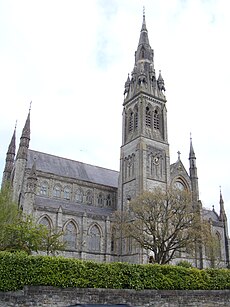Diocese of Clogher (Roman Catholic)
|
Diocese of Clogher Dioecesis Clogheriensis Deoise Chlochair |
|
|---|---|

|
|
| Location | |
| Territory | County Monaghan, most of County Fermanagh and parts of counties Tyrone, Donegal, Louth and Cavan; partly in the Republic of Ireland and partly in Northern Ireland |
| Ecclesiastical province | Province of Armagh |
| Statistics | |
| Area | 3,456 sq mi (8,950 km2) |
| Population - Total - Catholics |
(as of 2013) 114,300 88,203 (77.2%) |
| Information | |
| Denomination | Roman Catholic |
| Rite | Latin Rite |
| Cathedral | St Macartan's Cathedral, Monaghan |
| Patron saint | St Macartan |
| Current leadership | |
| Pope | Francis |
| Bishop | sede vacante |
| Metropolitan Archbishop | Eamon Martin |
| Emeritus Bishops |
Joseph Duffy, Bishop Emeritus of Clogher Liam McDaid Bishop Emeritus of Clogher |
| Map | |
 |
|
| Website | |
| clogherdiocese.ie | |
The Roman Catholic Diocese of Clogher (Irish: Deoise Chlochair) was formed in 1111 at the Synod of Rathbreasail as the see for the Kingdom of Uí Chremthainn. It is part of the Archdiocese of Armagh.
The original cathedral was in the village of Clogher in County Tyrone, site of a monastery founded in 454 by St. Macartan, who was appointed bishop by St. Patrick in the 5th century. Following the Reformation, Henry VIII confiscated Clogher Cathedral for his Church of Ireland and the Roman Catholic diocese was without a permanent see until 1851 when a decision was made to move to the larger town of Monaghan 32 kilometres south east of Clogher village. The foundation stone of a St Macartan's Cathedral was laid in Monaghan in June 1861. The cathedral was dedicated in August 1892.
Today the diocese has a faithful of over 100,000 parishioners spread across 37 parishes. Diocese is currently vacant.
The Diocese straddles the Irish border, consisting of County Monaghan, much of County Fermanagh with parts of Counties Tyrone and Donegal. The main towns are Clones, Enniskillen and Monaghan.
The shrine of the diocese originally housed a copy of the Gospels and the Cross of the Clogher Diocese. According to tradition, these were originally given to St. Macartan by St. Patrick, although the manuscript as it exists today dates from the eighth century. Today these relics of ecclesiastical art are at the National Museum of Ireland in Dublin.
...
Wikipedia
